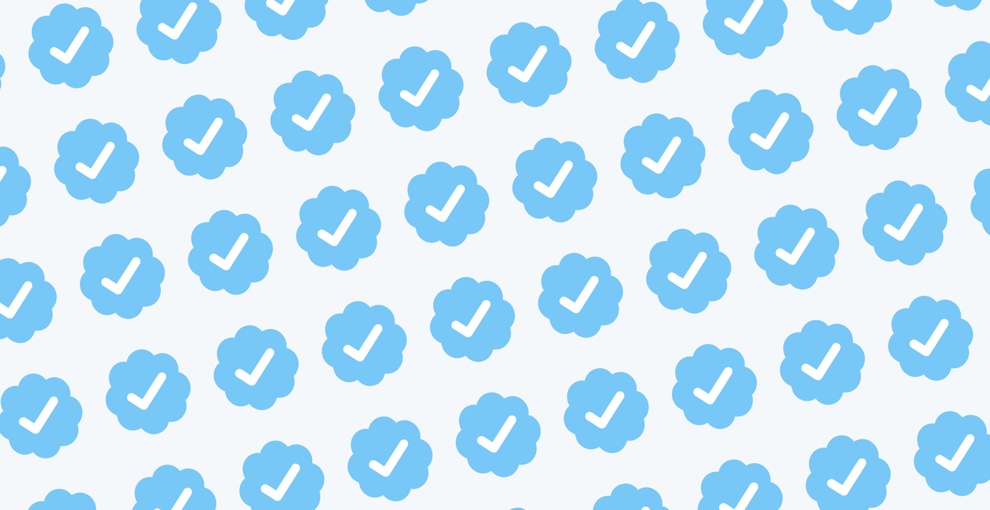
Yesterday, Twitter announced a significant change to its blue-check “verified account” program:
Today we announced that we’ve created an online application process for Twitter accounts to receive verified status.
Verified accounts on Twitter allow people to identify key individuals and organizations on Twitter as authentic, and are denoted by a blue badge icon. An account may be verified if it is determined to be of public interest. Typically this includes accounts maintained by public figures and organizations in music, TV, film, fashion, government, politics, religion, journalism, media, sports, business, and other key interest areas.
Our goal with this update is to help more people find great, high-quality accounts to follow, and for creators and influencers — no matter where they are in the world — to easily connect with a broader audience.
This was interpreted by many in the press as Twitter letting anyone get verified, assuming they know how to fill out an online form properly. (A sampling: “We Can All Be Verified On Twitter Now.” “You Can Finally Get a Verified Twitter Account.” “Blue ticks for all.” “Verified accounts for everyone.”) I confess that’s how I reacted to the first tweets about the news, before reading the details.
But those details confirm that the bar for becoming verified hasn’t changed, only the process. Twitter still gets to decide whether or not you are “of public interest” or work in a “key interest area.” And even this morning, just a few hours after the announcement, it’s becoming clear that this isn’t verification for all, as Twitter users start reporting their rejections.
Here’s my friend John Overholt, a prominent curator at a library here at Harvard, who has 11,000 followers:
Wow, rude. pic.twitter.com/aqcDdWiKhw
— John Overholt (@john_overholt) July 20, 2016
@jbenton Yes, it's real, and I was surprised too–it suggests a process that's at least partially automated. Came in at 5:49 am.
— John Overholt (@john_overholt) July 20, 2016
And here’s Federico Viticci, one of the more prominent online writers about Apple, founder of MacStories, who has more than 44,000 followers:
Seven years of writing and a picture of your passport aren't enough to get verified by @twitter. Good job @verified pic.twitter.com/bJKDFkXaSg
— Federico Viticci (@viticci) July 20, 2016
The best part of @twitter's @verified process – without details, I can only infer I'm not interesting enough. pic.twitter.com/ptk6TH8Edk
— Federico Viticci (@viticci) July 20, 2016
And here’s someone I confess I don’t know named The Product Poet who has 145,000 followers, getting the same rejection letter:
Verified by @facebook, but not worthy of @Twitter. At least I'm verified by the people. 😢
👉🏻https://t.co/hCPiGtZSyY pic.twitter.com/5ggHi8uduL
— The Product Poet (@ProductPoet) July 20, 2016
Judging one’s self-worth by Twitter follower count is not something I recommend! But nonetheless, having 12,000 followers — much less 44,000 or 145,000 — puts you waaaay up the Twitter-user percentile rankings. And journalists like Viticci have long gotten an edge in verified status. So it’s confusing.
To be fair, it does appear that lots of people are being verified through this process too; the number of accounts @Verified is following has grown by several hundred since yesterday.
Got a blue tick by @twitter , thank you & Here's a huge shout out to @ShulemStern for making this happen @twitter @TwitterIndia @verified
— Yasmin Karachiwala (@YasminBodyImage) July 20, 2016
Looks like Twitter is already verifying lots of accounts… I still wouldn’t trust anything I say on here personally
— Jordan Kahn (@JordanKahn) July 20, 2016
Twitter me ha verificado, ahora me siento como una niña de verdad.
— Gabriela Gonzalez (@gabriela2400) July 20, 2016
But given both Twitter’s original wording and these (and other) rejections, it seems this is more of a logistical shift than a philosophical one — a way to avoid knowing someone at Twitter to get the blue check. (It’ll hopefully cut back on the dozen or so asks I get a year for a verification “in.”)
Possibly to give their poor staff some respite at social occasions.
— James Ball (@jamesrbuk) July 19, 2016
Why does any of this matter, anyway? (A good question to ask about so many Internet-related things!) A couple reasons.
First, verified users have access to slightly different tools. Most prominently, as a verified user I can filter my Notifications stream to include only replies, likes, and retweets from other verified users. It’s not something I ever use, but I imagine it could be of use to celebrities or other people with far larger followings than I have. The verified can also opt out of group DMs, which is nice.
But the real reason it matters is that verification on a large scale would be one path for Twitter to deal with its massive abuse problems, which reared up for the 14 bajillionth time yesterday. If a significant share of Twitter users were verified, it would be easier for Twitter to make something like “Show notifications and replies only from verified users and people I follow” the Twitter default view. That might (a) disincentivize abuse a little, as Twitter assholes wouldn’t be so confident their abuse would reach their targets, and (b) further incentivize the unverified to get on board as they worry about their messages not reaching people. In other words, changing verified status from something a thin elite has to something Twitter’s middle class has could make it easier to reduce the bad behavior that it turning so many people away from the platform.
That’s not the only path Twitter could take to battle abuse, of course. But it’s clear needs to do something substantially more than it is currently, and these verification rejections would seem to be a data point that it isn’t the plan.